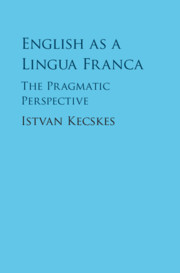Book contents
- English as a Lingua Franca
- English as a Lingua Franca
- Copyright page
- Contents
- Figures
- Tables
- Acknowledgments
- Introduction
- 1 The Nature of English as a Lingua Franca
- 2 Linguistic Creativity in ELF
- 3 Interactional Competence
- 4 Sociocultural Background Knowledge
- 5 Speaker’s Intention
- 6 The Semantics–Pragmatics Interface
- 7 Implicatures
- 8 Modality
- 9 Dialogic Sequences and Odd Structures
- Epilogue
- References
- Index
8 - Modality
Published online by Cambridge University Press: 18 November 2019
- English as a Lingua Franca
- English as a Lingua Franca
- Copyright page
- Contents
- Figures
- Tables
- Acknowledgments
- Introduction
- 1 The Nature of English as a Lingua Franca
- 2 Linguistic Creativity in ELF
- 3 Interactional Competence
- 4 Sociocultural Background Knowledge
- 5 Speaker’s Intention
- 6 The Semantics–Pragmatics Interface
- 7 Implicatures
- 8 Modality
- 9 Dialogic Sequences and Odd Structures
- Epilogue
- References
- Index
Summary
The chapter argues that ELF users do not create new modal expressions; they rely on the rich repertoire that the English language offers to them. But those English modal expressions do not necessarily reflect the mindset of ELF users with different L1s. Rather they reflect the mindset of native speakers of English. So an attempt is made to explain the interplay of these two factors in the use of modal expressions by ELF interlocutors. It is argued that modal use in ELF is motivated by three important factors: language learning experience, effect of L1 and immediate communicative needs.
Keywords
- Type
- Chapter
- Information
- English as a Lingua FrancaThe Pragmatic Perspective, pp. 184 - 205Publisher: Cambridge University PressPrint publication year: 2019

